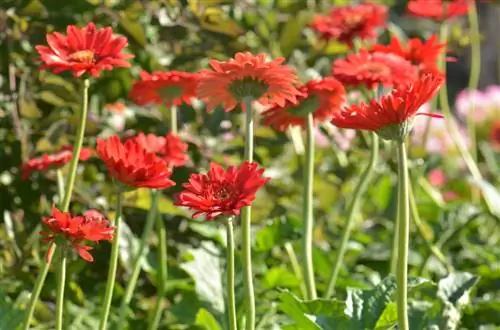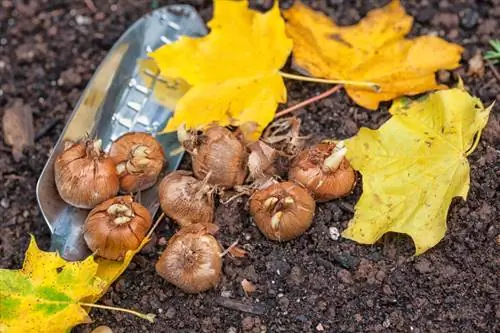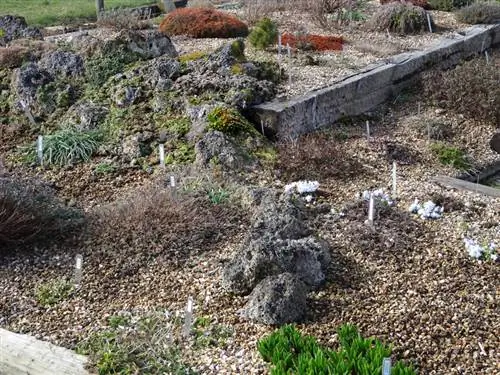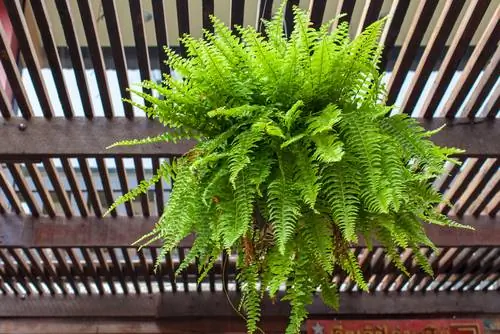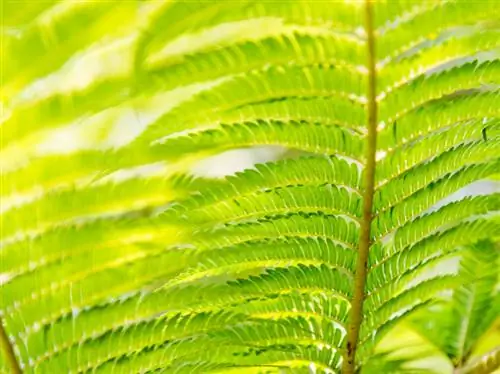- Author admin [email protected].
- Public 2023-12-25 17:45.
- Last modified 2025-01-23 11:22.
Fern transforms the garden, balcony and living room into a green refuge. Biodiversity inspires our imagination to come up with creative design ideas. When it comes to cultivation, the original form of prehistoric fauna requires a rethink. However, the plant is not difficult to plant and care for.

How do you properly care for fern?
To properly care for the fern, you should water and spray it regularly with lime-free water, fertilize organically, remove withered leaves and plant it in a partially shaded to shady position with moist, fresh soil that is acidic to minimally calcareous.
Planting a fern correctly
When planting, pay attention to the special botanical structure of the primeval fern and set the course for a decorative foliage plant that is as magnificent as it is uncomplicated. Choose a semi-shady to shady location with fresh, moist soil rich in soil organisms. During the preparation work, place the root ball in lime-free water until no more air bubbles appear. How to plant fern correctly:
- The planting pit has twice the volume of the root system
- Add mature compost, ericaceous soil, peat and horn meal to the excavation
- Insert the potted young plant and water generously overhead
Finally, mulch with leaves, grass clippings or bark mulch. As long as there is still a risk of delayed ground frost, a garden fleece protects the plant from frostbite at night.read more
Care tips
The guide for proper fern care is dominated by an extensive supply of water via the roots and leaves. All other clues follow this. The relevant factors at a glance:
- Water fern regularly and spray with lime-free water
- Fertilize organically every 4 weeks from April to mid/end of September
- Provide potted plants with liquid fertilizer for ferns
- Cut out wilted leaves during the season
- Perform ground-level pruning in January/February
If the fern functions as a decorative houseplant, there is no need to cut it back completely. If temperatures remain consistently warm, the plant does not take a winter break. Therefore, continue to apply fertilizer every 4-6 weeks from October to March.read more
Which location is suitable?
Declared as a shade plant, fern should not live completely cut off from sunlight. Mild morning or evening sun is even desirable for vital growth. This is how the light and temperature conditions should be at the location:
- Partly shaded to shady location
- No blazing sun or stagnant heat at midday
- I like to be on the cool edge of the woods, airy, but not exposed to the wind
The higher the humidity, the less maintenance required. If you cultivate fern as an indoor plant, it will thrive in the bathroom or other humid rooms.read more
The correct planting distance
The selected species and variety defines the planting distance. The following overview sets out the general conditions for small, medium and large ferns:
- Small ferns up to 40 cm high: planting distance 25-35 cm
- Medium-sized ferns 40-80 cm height: planting distance 45-55 cm
- Large ferns 80-120 cm height: planting distance 70-100 cm
What soil does the plant need?
The closer the quality of the soil is to loose forest soil, the more frugal the plant is in care. Ferns value the following attributes:
- Nutritious, humic and permeable
- Fresh, moist, yet without waterlogging
- Acidic to minimally calcareous
What is the best time to plant?
The ideal planting time outdoors is from the end of March/beginning of April to the beginning of June. It is better to only put a frost-sensitive plant in the ground after the Ice Saints. Indoor ferns are planted all year round.
When is flowering time?
As a vascular spore plant, fern does not rely on attracting insects and other pollinators for reproduction. A flower will therefore not appear on the foliage plants.
Cut fern correctly
Cut dry leaves at the base during the growing season to make room for fresh growth. If the plant thrives in the bed, the root system will pull in the leaves by winter at the latest. Ideally, the withered fronds remain on the plant until January/February as additional protection against frost and snow, before being shortened close to the ground. If you cultivate the fern behind glass in the room or winter garden, there is no need to cut it back completely.read more
Watering fern
The plant comes from the rainforests of the tropics, where the sun never breaks through the twilight and the air contains 90 percent moisture. With the help of the correct casting technique, it is possible to create an almost tropical microclimate for vital growth. This is how you handle this central care issue professionally:
- Water the fern abundantly and regularly with soft water
- Spray or water the leaves every 1-2 days
Apart from exceptions, such as floating fern, the plant should not be exposed to permanent waterlogging.read more
Fertilize ferns properly
All ferns are naturally sensitive to lime and s alt. In addition to using soft irrigation water, take this requirement into account with the following nutrient supply:
- Fertilize the fern in the bed once a month from April to September with compost or nettle manure
- Administer liquid special fertilizer for ferns in the bucket every 14 days
Since indoor ferns retain their green fronds all year round, apply liquid fertilizer (€8.00 at Amazon) in a diluted concentration every 4-6 weeks from October to March. Ideally, you add the preparation to the irrigation water to spray the plant with it.read more
Diseases
Over millions of years of evolution, ferns developed robust resistance to disease. Regardless, the need for constant moisture sometimes causes fungal infestation. Rot fungi in particular cause the leaves to turn brown and the plant dies. Thin the fern thoroughly and create better water drainage. In addition, cinnamon powder has a defensive effect on the spores when scattered on the substrate.read more
Pests
Fern is one of the preferred prey patterns of black weevils and snails. To get rid of the voracious pests, do this:
- Take action against black weevils with bait traps prepared with nematode gel
- At the same time, fight the larvae in the soil with nematodes dissolved in water from the watering can
- Keep snails away with traveling barriers made of pottery shards, grit or other sharp-edged materials
- Coffee grounds scattered around the plant have a toxic effect on the voracious pests
Wintering
The majority of ferns are frost hardy. Over the course of the winter, the plant sheds its leaves in order to sprout freshly at the beginning of the next season. If you cultivate the foliage plant in a pot or if the garden is in a rough location, we recommend these protective measures:
- Leave the withered leaves on the fern until late winter
- Hill up the plant with leaves, compost, straw or conifers
- Wrap a planter in bubble wrap and place it on a wooden block
- Water on frost-free days if there is no snow or rain
read more
Propagate fern
These methods are available for breeding ferns:
- Division of the root balls or rhizomes in spring: by far the most uncomplicated propagation
- Sowing spores harvested from the undersides of leaves: labor-intensive and time-consuming
Shield fern develops kindles in the armpits of its fronds on its own. These are cut out and then rooted in disinfected potting soil within a few weeks.read more
How do I transplant correctly?
Do not allow ferns to move until they are older than 4 years old. For this measure, choose an overcast day in April or May so that the plant can root well in the new location during the summer. Follow these steps:
- Dig the root area with the spade in the radius of the expected growth height
- Loosen with the digging fork and lift it out of the ground
- The new planting pit has twice the volume of the root ball
Do not plant the fern deeper than its previous location. Ideally, you enrich the excavation with compost, ericaceous soil and horn shavings. To ensure that the plant grows quickly, water thoroughly every 1-2 days for the first 2 weeks.read more
Fern in a pot
Fern thrives in the pot when the plant has a nutrient-rich, loose and structurally stable substrate. Cover the soil with shards of pottery or expanded clay as drainage, as waterlogging causes root rot. This is how the care is exemplary:
- Water thoroughly when the substrate is dry
- Spray every 2-3 days with soft, room temperature water
- Fertilize every 2 weeks from April to September, every 4-6 weeks from October to March
- Cut off wilted fronds regularly at the base
Use predominantly decalcified irrigation water and fertilize with low-s alt special fertilizer for ferns.
Is fern poisonous?
Caution is advised when dealing with ferns because they are all poisonous. The extent of their toxicity varies from plant to plant. As a result, cultivation within the reach of children and pets is not recommended. Wearing gloves is mandatory during care and planting work.read more
Brown leaves
Brown leaves on ferns indicate frost damage or rot. If delayed ground frost can be ruled out as the cause, check the plant for waterlogging and rot fungi. If in doubt, change the location, optimize the water supply and thin out the fern. Dust the diseased plant repeatedly with rock dust and also add cinnamon powder to the substrate.read more
Yellow leaves
Yellow leaves on ferns are a characteristic symptom of leaf chlorosis. This is an undersupply of the plant with iron, which is deposited due to too high a lime content in the soil. Therefore, only water with soft water. A special iron fertilizer from specialist retailers provides short-term relief.
The most beautiful varieties
- Whitley Giant: Beginner-friendly, medium-sized spotted fern for moist, shady locations; Growth height up to 40 cm
- Goldscale Fern: wintergreen plant with golden shimmering leaf undersides; Growth height 50-100 cm
- Crispa Whiteside: lush fern with curled fronds all year round; Growth height 80 cm
- Hirschtongue: lime-tolerant variety with pinnate leaves that thrives even in the deepest shade; Growth height 30-60 cm
- Barnesii: magnificent worm fern with curly, tightly upright feathery fronds; Growth height 90-100 cm
- Peacock Wheel Fern: graceful, light green fronds on black stems for humid locations; Growth height 40-50 cm


